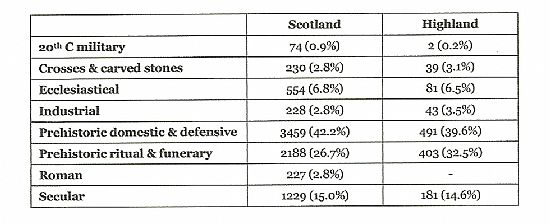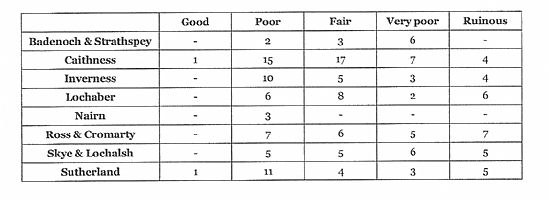INVERNESS & BLACK ISLE U3A
STUDY DAY
Landscape and Heritage
In this workshop we will be discussing the archaeological and historic built environment structures that remain visible in the Highland landscape. In particular, we will be asking how we determine the ‘value’ of what remains, how we decide how much is worth preserving, and the criteria we use to ensure that the ‘best’ is preserved. The data below indicates the categorisation systems that currently exist to aid these decisions.
World Heritage Sites:
World heritage sites are places of outstanding universal value. Scotland currently has five world heritage sites: Antonine wall; Neolithic Orkney; New Lanark; Old & New Towns of Edinburgh; St Kilda. None of these are in the Highland Council area.
Scottish Castles Register:
The Scottish castle conservation register identifies ruined castles and tower houses that could be successfully restored and reused. There are currently 26 castles on the register, one of which (Fairburn Tower) is in the Highland Council area.
Scheduled Monuments:
A heritage asset is a part of the historic environment that is ‘valued’ because of its historic, archaeological, architectural or artistic interest. Only some of these are judged to be important enough to have extra legal protection through designation. A scheduled monument is a designated 'nationally important' archaeological site or historic building that has been given additional legal protection against unauthorised change. Scheduling is the responsibility of Historic Scotland.
Currently, there are 8189 Scheduled Monuments in Scotland of which 1240 are in the Highland Council area. There are eight categories of schedule.

Listed Buildings:
A listed building is any building or structure which is considered to be of special architectural or historic interest. There are three categories. Category A are buildings of national or international importance, either architectural or historic, or fine little-altered examples of some particular period, style or building type. Category B are buildings of regional or more than local importance, or major examples of some particular period, style or building type which may have been altered. Category C(S) are buildings of local importance, lesser examples of any period, style, or building type, as originally constructed or moderately altered; and simple traditional buildings which group well with others in categories A and B.

Currently there are 47,555 listed buildings in Scotland, of which 3040 are in the Highland Council area. Individual civic parish lists can be created but there are no specific categories of listed building. However, keyword searches can generate the number of listings for various types of structure, for example:

Buildings at Risk:
The Buildings at Risk Register for Scotland highlights properties of architectural or historic merit throughout the country that are considered to be at risk or under threat. A building does not necessarily need to be in poor condition, it may simply be standing empty with no clear future use.
There are currently 2487 buildings on the register, of which 172 are in the Highland Council area. Entries are classified by condition (see table below), location type, category of listing and category of risk.

Canmore:
Canmore is Scotland’s national inventory of historic and archaeological sites and buildings, provided by the Royal Commission on the Ancient and Historical Monuments of Scotland (RCAHMS). The ever-expanding, on-line and fully-searchable collection now holds location information, site details and images on more than 300,000 archaeological, architectural, maritime and industrial sites throughout Scotland.
Highland Council Historic Environment Record:
The Highland Historic Environment Record (HER) is the on-line searchable database of archaeological sites and historic buildings for the Highland Council area. All new Canmore records for the Highland area are uploaded to the Highland HER annually. Other areas of Scotland also have HERs but not all are searchable on-line. Both Canmore and the Highland HER are map-based. They show listed buildings, scheduled monuments, find spots and other monuments and buildings on a zoomable map searchable by place name, postcode or grid reference. Currently there are 54,476 records in Highland HER, covering the eight administrative areas and 96 civil parishes. The database can be searched using a glossary of 6216 keywords. The numbers of records held for some typical keywords are given in the table below.

Conservation Areas:
These are areas that planning authorities consider to be of special architectural or historic interest, the character or appearance of which is desirable to preserve or enhance. They may vary in size from whole town centres and estate villages to single squares, terraces or small groups of buildings. Within Scotland there are currently 645 conservation areas. In the Highland Council area there are currently 30 conservation areas, of which 12 are classified as ‘outstanding’.

Summary of Disccussion Group on Heritage
There were eight participants in the Heritage discussion group. The agenda, based on the Heritage fact-sheet issued with the Study Day papers, was wide-ranging, mainly considering issues around the processes involved in the designation, preservation and conservation of the built heritage of the Highlands.
The main theme that emerged from the discussion was that a great deal of confusion exists over the many different national schemes whereby built heritage of the Highlands is classified and designated by the various responsible public bodies and organisations. There also appears to have been little public engagement either about what constitutes a historic building or landscape worthy of preservation for posterity as a historic monument or a visitor attraction, or any public debate about what criteria should be used to place a ‘value’ on a building or landscape. In consequence, the criteria used by each of the separate responsible bodies appear to be ill-defined, leading to ill-understood and apparently inconsistent decisions.
Several issues were raised by the discussion group. For example
(i) There seems to be a disproportionate balance in the types of building that are regarded as worthy of maintenance and conservation. There is evidence of ‘favouritism’ towards the stately home with its precious artefacts and memorabilia – as opposed to the historic vernacular crofts, cottages, smithies and parish churches that truly defined the daily lives of most Highland communities;
(ii) This imbalance often leads to conflict between the responsible bodies and the civic trusts and local heritage societies who generally believe public expenditure should not be so focussed on the lives of the wealthy upper class, but should reflect a more realistic overall picture of the history of the Highlands;
(iii) The range of buildings currently designated and conserved seems to be limited. In the Highlands, very few commercial, economic or industrial sites seem to be recognised as having heritage value. The historic role of, for example, the Invergordon smelter is un-acknowledged, as is the past significance of the area’s harbours, farms, quarries and mills. There was also concern that there seemed to be little current consideration of what might ultimately be preserved of the hugely important Dounreay site;
(iv) In the few cases in which local rural landscapes have been conserved (notably by subscription or volunteer heritage societies, rather than by the publicly-funded bodies), generally it is only the tangible physical buildings and artefacts that remain. It was considered that there was a strong case for recording and preserving for future generations the intangible histories – such as the family histories, memories and craft skills associated with these buildings.
